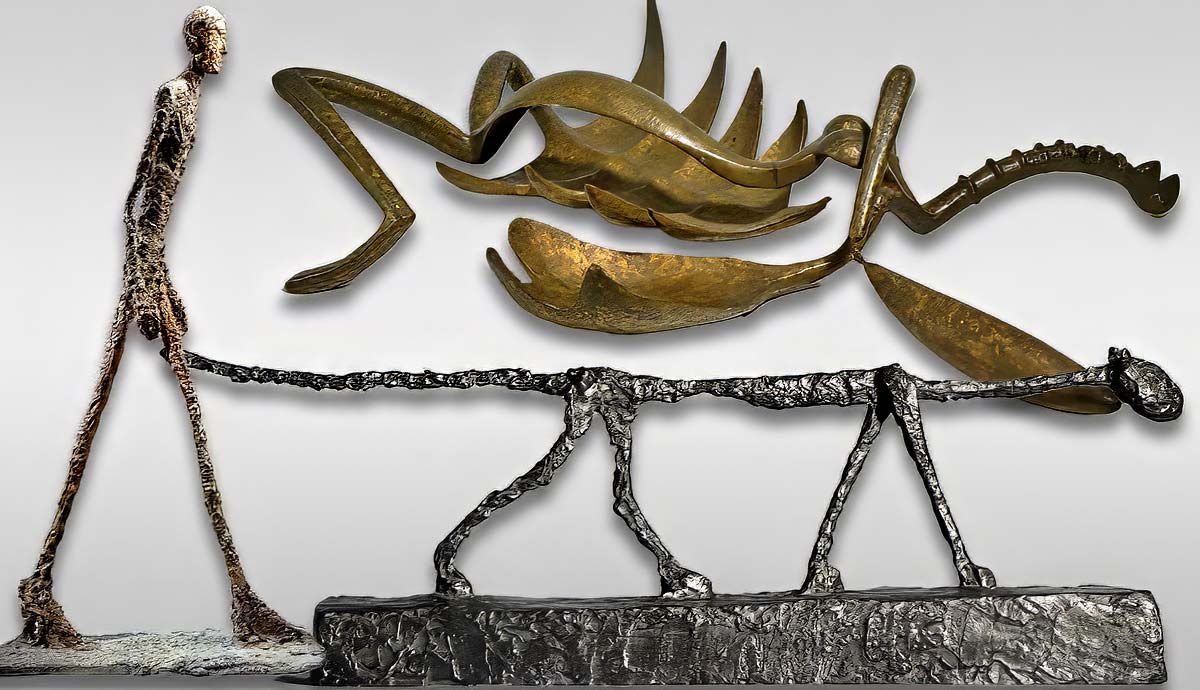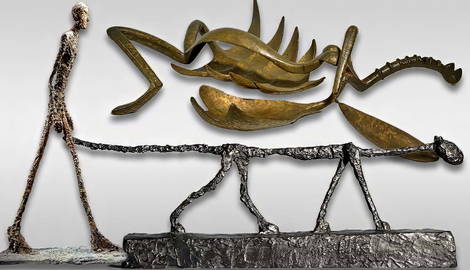
Alberto Giacometti was one of the most prominent sculptors of the twentieth century. His works embodied post-war disillusionment and collective trauma. The thin sculptures he created became the emblems of modern art, but let’s explore what makes Giacomett’s works so special and different from others.
Who Was Alberto Giacometti?

Alberto Giacometti was born in 1901 in Switzerland. He started his artistic practice in his early twenties and soon became one of the most promising young sculptors of his time. Today, as more than a century has passed since his birth, Giacometti is regarded as the most important sculptor of the twentieth century, with his works being the most expensive sculptures ever sold.
Looking at his family, it felt like Giacometti had to become an artist. His father and uncle were painters—a Post-Impressionist and a Symbolist respectively—and his godfather was a Swiss Fauvist called Cuno Amiet. It was as if the most progressive artistic ideas ran in the family, leaving almost no choice for the young Alberto but to become an artist. Giacometti’s parents even named one of his younger brothers after Diego Velazquez.
Although the idea to become a professional artist came to Alberto Giacometti rather early, it was unclear to him if he wanted to be a painter or a sculptor. Yet, as his artistic practice developed, he found painting unfit for his character. Although he left a substantial amount of painted works, he complained about his struggle to finish them. Perhaps, this was already an expression of his sculptural style: Giacometti’s sculptures were more about the exposed carcasses, the elements lacking, the barely-there silhouettes. Unlike many of his colleagues, Giacometti also believed in the superiority of photography when it came to portraits. He claimed that the new medium had eliminated the need for naturalistic painting.
The Formative Events

Two formative episodes that happened in Giacometti’s early artistic practice partially shaped his later oeuvre. In 1921, the artist moved to Rome to study art, living in the villa that belonged to his distant relatives. Almost immediately, the young artist fell in love with the host’s daughter, fifteen-year-old Bianca. Bianca had even less clue about romantic affairs than Alberto and was apparently annoyed by his attempts to impress her. Desperately in love, the artist tried to create her sculptural portrait, but Bianca shoved the half-finished bust from the modeling stand, breaking it into pieces. In his notes, the embarrassed and heartbroken artist insisted that he broke the sculpture himself during an emotional crisis.
The second formative event happened the same year during a trip to Venice with Pieter van Meurs, a Dutch state archivist who met Giacometti on a train to Pompeii and was intrigued by the young and promising artist. However, their tour of Venice never happened. One night, Van Meurs started suffering from intense pains caused by kidney stones. He died in agony early in the morning, with Giacometti witnessing his pain and hearing his screams. He never fully recovered from this experience, refusing to sleep without the lights on until his last days.
The Surrealist Basis of Giacometti’s Work

Alberto Giacometti’s rise to fame was rather a swift one. In 1928, he exhibited with a group of Italian artists in Paris. The critics were nice to him, and Jean Cocteau even wrote that he had seen sculptures by Giacometti that are so powerful, and yet delicate, that one wants to describe them as snow preserving the footprint of a bird. The sculptures from Giacometti’s Surrealist period never represented anything in particular, they were the thin and fragile forms brought into his mind fully formed as they were.
Initially, Giacometti associated himself with the Surrealist movement and even participated in their group exhibitions, but his friendship with the Surrealists collapsed in 1935. The formal reason was Giacometti’s short-lived collaboration with the interior designer Jean-Michel Frank. Andre Breton, the leader of the Surrealists, arranged a special meeting to shame Giacometti and formally accuse him of betraying the movement’s principles. Outraged, Giacometti left the meeting and the movement, not giving Breton the pleasure to embarrass him.
Stylistic Influences and Interpretations

Giacometti’s sculpture Disagreeable Object plays into the Surrealist idea of exploring the subconscious and unspoken, with an indefinite title only deepening the viewer’s inquiry. The topics of sex and violence, important to Surrealism, were also present in the work of Giacometti throughout his entire life. Like many artists of the early twentieth century, Giacometti could not avoid reflecting on the legacy of Cubism. His early works often consisted of bulky geometric forms reminiscent of broken columns.
Giacometti was also influenced by Ancient Egyptian art. Art historian Laurie Wilson wrote that Giacometti shared the Egyptian idea of a sculptor bringing dead material to life with their hands. As a young artist, he had seen Ancient Egyptian sculptures in the workshops of artists who were restoring them.
Soon after leaving the Surrealists behind, Giacometti switched from abstract sculptures to figurative ones. Starting with small sculptures, Giacometti gradually moved toward making large-scale objects. Yet, they were minimalistic in a very specific sense. Alberto Giacometti gradually peeled layer of matter after layer until his figures became so thin they almost vanished. Despite their size, the figures’ proportions look like silhouettes seen from a great distance, looming on the horizon.
Giacometti’s Men and the Existentialist Philosophy

Like many other artists of the post-war era, Giacometti searched for new ways to depict humanity after the horrors of World War II, chemical weapons, and concentration camps. Giacometti’s skeletal figures were the remains of a humanity that was exhausted and disillusioned. Giacometti’s The Walking Man has no destination and no goal, his movement is frantic, his gestures weak.
Like many post-war artists and writers, Giacometti embraced the philosophy of Existentialism. Existentialists denied the predetermined meaning of life or the existence of any kind of divine authority figure. Each person had to develop their own life goal, yet the burden of this task was so heavy that it could crush the person’s spirit and lead them to a deep crisis. Giacometti’s human figures clearly had not yet found their purpose and were crushed by the weight of their absolute freedom.
Giacometti’s Women

The series of fifteen standing sculptures of nude women titled Women of Venice does not show any of the frantic pace and anxiety of Giacometti’s male figures. The main inspiration for them came from the sculptor’s wife, Annette Giacometti. These figures seem full of dignity and grace.
Giacometti created fifteen clay sculptures, but all of them were mutually exclusive, made from a single piece of clay on a single carcass. Out of fifteen figures, only nine were cast in bronze. Giacometti insisted that there was no progress in the series and every sculpture was just as provisional as the first one.
Alberto and Annette Giacometti met during World War II. He was a refugee who fled France to his native Switzerland, while she worked for the Red Cross. It is unlikely that she had any artistic inclination herself, yet soon after their marriage, she voluntarily became Giacometti’s manager. After his death in 1966, she turned her focus to protecting her late husband’s work by cataloging his pieces and fighting forgers.
Animals and Alberto Giacometti

The idea for the Cat sculpture came to Giacometti after he saw his brother’s cat wandering around the house and moving through the tightest spaces possible. Giacometti was definitely a cat person. Once he even stated that he would rather save a cat than a painting made by Rembrandt from a burning building.
In the vast oeuvre of Giacometti, only three figures show animals: Cat, Dog, and Two Horses. The Dog sculpture was both an illustration from memory and an expression of the artist’s emotional state. In his later interviews, he remembered seeing a Chinese dog on the street and its image got stuck in his mind. Later on, during another one of his crises, he remembered the dog’s sad face. Giacometti never specified the breed of the dog he saw or portrayed, but the sculpture’s build is similar to that of a Xigou.
The last sculpture from the animal series was never publicly displayed. Two Horses was a sculpture that was apparently too big to fit the artist’s studio. So when the artist took it outside, the rain started pouring, dissolving the plaster cast.










